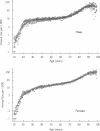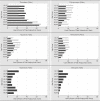Changes in antipsychotic drug prescribing by general practitioners in the United Kingdom from 1991 to 2000: a population-based observational study
- PMID: 14651732
- PMCID: PMC1884397
- DOI: 10.1046/j.1365-2125.2003.01905.x
Changes in antipsychotic drug prescribing by general practitioners in the United Kingdom from 1991 to 2000: a population-based observational study
Abstract
Aim: To estimate changes in the frequency of use of various antipsychotic drugs in the UK from 1991 to 2000 and to relate these changes to patients' characteristics.
Methods: We conducted a population-based observational study using data from general practices that contribute information to the General Practice Research Database (GPRD). The study population comprised men and women 10-99 years old. We estimated annual use, first-time use, duration of use and, in a sample of 200 patients, indications for use of various antipsychotic drugs, and we observed how these measures had changed over the past decade.
Results: The annual use of antipsychotic drugs increased from 10.5 per thousand in 1991 to 12.2 per thousand in 2000, an overall increase of 16%. The increase was greater in men (25.2%) than women (2.7%). At the same time, the rate of new use of antipsychotic drugs was stable in men and decreased by 21% in women. The difference between patterns of annual use and rates of new use is attributable to the increasing average annual duration of treatment in both men and women during the past decade. Thioridazine, which the UK Committee on the Safety of Medicines (CSM) recently recommended should be used only for second-line treatment of schizophrenia in adults, was the most commonly prescribed antipsychotic throughout the study period. Its use increased as a proportion of all antipsychotic drug use from 1991 to 2000 in men and women aged 10-69 years, but decreased in older users. More than half of all first-time use of antipsychotic drugs in the sample of patients we evaluated was for treatment of depression, anxiety states, and panic disorders, while less than 10% was for treatment of schizophrenia and other psychoses.
Conclusion: The use of antipsychotic drugs has increased in the UK during the past decade, primarily due to increased average annual duration of use rather than higher rates of new use. Most antipsychotic drug use appears to have been prescribed to treat nonpsychotic disorders. It will be of interest to see whether the use of thioridazine, which was the most widely prescribed antipsychotic during 1991-2000, decreases during the next decade in response to the recent CSM recommendation.
Figures


 ) and 2000 (
) and 2000 ( ).
).
 ) and 2000 (
) and 2000 ( ).
).
References
-
- Commitee on Safety of Medicines. Thiroadizine: Restricted indications and New Warnings on Cardiotoxicty. Available at: http://www.medicines.mhra.gov.uk/ourwork/monitorsafequalmed/safetymessag...
-
- Frangou S, Lewis M. Atypical antipsychotics in ordinary clinical practice: a pharmacoepidemiologic survey in a south London service. Eur Psychiatry. 2000;15:220–226. - PubMed
-
- Owen RR, Feng W, Thrush CR, Hudson TJ, Austen MA. Variations in prescribing practices for novel antipsychotic medications among Veterans Affairs hospitals. Psychatr Serv. 2001;52:1523–1525. - PubMed
-
- Weissman EM. Antipsychotic prescribing practices in the Veterans Healthcare Administration – New York metropolitan region. Schizophr Bull. 2002;28:31–42. - PubMed
-
- Covell NH, Jackson CT, Evans AC, Essock SM. Antipsychotic prescribing practices in Connecticut's public mental health system: rates of changing medications and prescribing styles. Schizophr Bull. 2002;28:17–29. - PubMed
MeSH terms
Substances
LinkOut - more resources
Full Text Sources
Miscellaneous

